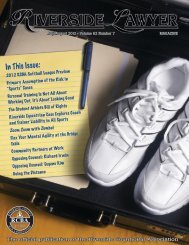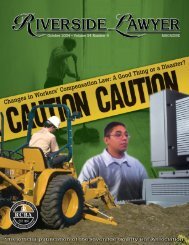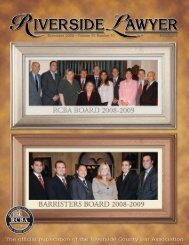In This Issue: - Riverside County Bar Association
In This Issue: - Riverside County Bar Association
In This Issue: - Riverside County Bar Association
Create successful ePaper yourself
Turn your PDF publications into a flip-book with our unique Google optimized e-Paper software.
Some Thoughts on Mechanical Restraints<br />
by Elyn R. Saks<br />
<strong>In</strong> 1986, I published my law school note on “The Use of<br />
Mechanical Restraints in Psychiatric Hospitals” in the Yale<br />
Law Journal. I started with a vignette:<br />
Julia, a newly admitted psychotic patient,<br />
suddenly breaks a plastic spoon while she is eating<br />
lunch. She appears amused, slightly fearful, and<br />
a touch defiant. Staff suggest that she needs to be<br />
restrained. When Julia resists, six orderlies converge<br />
on her, pin her to her bed, and, despite her struggles,<br />
cuff her limbs with thick leather straps. Finally, they<br />
immobilize her torso with a body net. Tied spreadeagle<br />
to the bed, unable to move, Julia is now in “sixpoint”<br />
restraints.<br />
<strong>In</strong> time Julia’s physical pain will increase.<br />
Her ankles and wrists will bruise; her body will ache<br />
from the forced immobility. Although she will beg<br />
for release (many patients do), Julia will neither be<br />
let go, nor told when staff plan to untie her. Alone,<br />
frightened, and in pain, she will begin to struggle<br />
again – a signal to the staff that she needs to be<br />
restrained longer.<br />
I did not say this at the time, but Julia was actually me. I<br />
had brandished that plastic spoon. I believe that the real risk<br />
that I would actually hurt anyone was minimal. Still, my chart<br />
said “use restraints liberally.” And they did. <strong>In</strong> a three-week<br />
period, I was restrained every day for at least several hours<br />
and a couple of times for over 20 hours. I then transferred<br />
to another hospital, and although my behavior didn’t change<br />
in the least, I stopped being restrained. <strong>In</strong>deed, it is a robust<br />
finding in the literature that whether you are restrained has<br />
less to do with your patient characteristics, the staff/patient<br />
ratio, etc., and more to do with the culture of the ward.<br />
Restraints are very consequential. Most horribly, they can<br />
lead to death – through asphyxiation, aspirating one’s vomit, a<br />
heart attack. A Harvard statistician estimated that one to three<br />
people die in restraints each week in this country. It is unclear<br />
whether restraints are saving or actually costing lives.<br />
<strong>This</strong> point came home to me when, a week after presenting<br />
to the National Alliance on Mental Illness in San Diego, I<br />
was contacted by a woman named Shannon. “I don’t know if<br />
you will remember me,” she said. “I came up after your talk<br />
and told you about my brother. You talked about restraints<br />
when you were here, and just yesterday, he was restrained<br />
face-down and died.” Putting a human face on a restraint<br />
death was very powerful. Shannon has been a compelling<br />
voice advocating against restraints.<br />
Less extreme than death but still problematic, restraints<br />
can be greatly traumatizing. For me, they were the most traumatic<br />
thing that ever happened to me. I say that as someone<br />
who has suffered life-threatening illness. <strong>In</strong>deed, I experienced<br />
years of nightmares about restraints. <strong>In</strong> restraints, one<br />
is scared, helpless, dehumanized and degraded, and – after<br />
about ten hours – in great physical pain. Abuse survivors (I<br />
am not one) are said to experience even greater trauma.<br />
It needn’t be this way. There have been restraint reduction<br />
efforts in a number of places – e.g., Pennsylvania and<br />
Massachusetts. These efforts have worked in state hospitals,<br />
private hospitals, and even forensic hospitals. Key features<br />
of these efforts have been laid out. It has been shown that<br />
these efforts do not lead to greater costs or greater injuries.<br />
Nor, according to one study, did chemical restraints increase.<br />
Efforts in this regard are gaining momentum in the Los<br />
Angeles <strong>County</strong> Department of Mental Health, which has<br />
begun collecting data on restraint use.<br />
<strong>In</strong>deed, we have the example not just of several states over<br />
a short period of time, but of England, which has largely done<br />
without severe mechanical restraints for over 200. We should<br />
be able to do as well.<br />
When I wrote my first article on restraints, many articles<br />
had doctors reporting that restraints were a treatment; they<br />
helped patients feel safe. But when you listen to people begging<br />
to get out of restraints, and when you look at the literature<br />
surveying patients about their preferences for emergency<br />
treatment, with restraints usually coming out last, it is hard<br />
to credit this view. I think it’s very encouraging that in many<br />
places, restraints are now seen not as a treatment, but as a<br />
treatment failure.<br />
Tolerance of restraints may involve something deeper:<br />
a belief that mental patients don’t react as “regular” people<br />
would. A very cherished professor at Yale, a psychiatrist and<br />
psychoanalyst himself, had this to say when I talked to him<br />
about how degrading and painful restraints must be. He said:<br />
“You don’t understand, Elyn. These patients are psychotic;<br />
they are different from you and me; they don’t experience<br />
restraints as you or I would.” At that moment in my life I<br />
didn’t have the courage to tell him, “No, we are not all that<br />
different from you.”<br />
So, when you think about whether we should encourage<br />
or discourage the use of restraints – whether they are necessary<br />
or largely avoidable – put yourself in the shoes of those<br />
undergoing restraints. Keep the trauma and pain in mind.<br />
Elyn Saks is the Orrin B. Evans Professor of Law, Psychology,<br />
and Psychiatry and the Behavioral Sciences at USC. Her memoir,<br />
The Center Cannot Hold: My Journey Through Madness,<br />
was published in 2007.<br />
26 <strong>Riverside</strong> Lawyer, June 2012

















